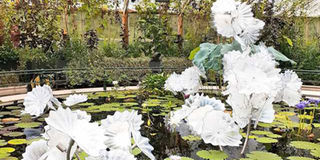The largest collection of living plants

Ethereal White Persian Pond - exploring the world's largest collection of living plants. PHOTO | COURTESY
What you need to know:
- The Royal Botanical Gardens, Kew, is the largest and the most diverse collection of living plants in the world.
- In it, you travel across five continents and onto 16 islands.
- The most memorable experience was the exhibition of glass artworks by Dale Chihuly spread across the gardens and in the Shirley Sherwood Gallery of Botanical Art.
Wow!” I said. “Wow!” We were at Kew Gardens, and this moment of wonder was when we walked through the doors to the Ethereal White Persian Pond. Have a look at the photograph. Do you blame me for
thinking the magnificent white lilies were real? Well, they are real — but they are made of glass.
As I wrote a couple of weeks ago, we were travelling around the south of England — staying for a few days each in the old Roman city of Bath in Somerset, the picturesque seaside town of Lyme Regis in Dorset,
and the seaport of Southampton in Hampshire. And my wife also wanted to go on a day trip to London. She didn’t want to do the things I would have thought of doing: shopping in Oxford Street, lunching at the
Savoy, seeing a play at the Globe Theatre. No, she wanted to walk round a garden. So that’s what we did. And I am glad that’s what we did. If you, too, go to London I would now strongly recommend a visit to
Kew Gardens.
But let me give you its proper name: the Royal Botanical Gardens, Kew. It is the largest and the most diverse collection of living plants in the world. Its brochure boasts of “stunning landscapes, iconic buildings and
glasshouses, and inspirational art galleries”. The boast, we found, is justified.
WORLD'S BIGGEST GLASSHOUSE
The Temperate House is certainly iconic. It is the world’s biggest glasshouse. In it, you travel across five continents and onto 16 islands. And it is not only an amazing collection, it is actually helping to save some of
the world’s rarest and most threatened species of plants. At the other climatic extreme, the Victorian Palm House has a vast collection of tropical and rainforest plants — among them, the world’s oldest pot plant.
Then there is the Princess of Wales Conservatory, with its collection of waterlilies. The biggest of them — a Victoria amazonica, with leaves two metres wide — has aromatic white flowers that open at sunset and
turn pink by the morning. But, unfortunately, we were not able to get inside the Hive, because some repair work was going on. It is a huge wire construction that replicates the world of the honeybee. It promises a
‘multisensory experience’.
And talking of sensory experiences … as well as all these sight and smell delights, there were some food things to taste as well. We counted six eating places on the map of Kew. It meant quite a long walk, but we
opted for the newest and, I think, the smartest — the Pavilion Bar and Grill — where we could eat alfresco on a leafy terrace.
CHIHULY ART
But the most memorable experience was not about the buildings, the plants or the lunch. It was about the exhibition of glass artworks by Dale Chihuly spread across the gardens and in the Shirley Sherwood Gallery
of Botanical Art. Chihuly must be one of the most famous artists working in glass. He has had installations in many cities, and his work is held in more than 200 museums and galleries across the world. He has said,
‘I want my work to appear like it came from nature, so that if someone found it on a beach or in the forest, they might think it belonged there’. After that I didn’t feel so embarrassed about my outburst at the Persian
Pond.
John Fox is Managing Director of iDC





